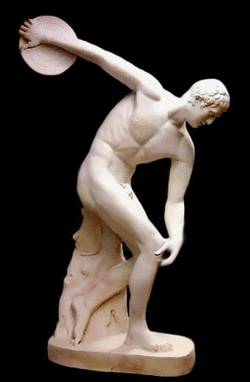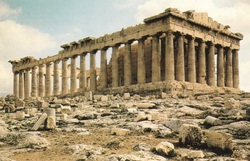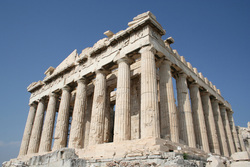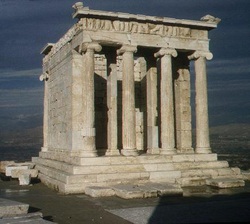Art and Architecture
"there is nothing in Greek civilization that doesn't illuminate our own" - Will Durant 1939
The Ancient Greeks introduced many new forms of art and architecture. They built upon the earlier Egyptian styles to develop their own. Subsequent civilizations, including the Romans and our modern society have learned from them and continue to espouse the same ideals of Beauty. From the realism, idealism and proportion (particularly as it developed in the Hellenistic age) of beautifully decorated columns, giant sculptures in exotic and expensive materials, and wonderfully decorated pottery, we have learned and copied from the Ancient Greeks.
The Ancient Greeks introduced many new forms of art and architecture. They built upon the earlier Egyptian styles to develop their own. Subsequent civilizations, including the Romans and our modern society have learned from them and continue to espouse the same ideals of Beauty. From the realism, idealism and proportion (particularly as it developed in the Hellenistic age) of beautifully decorated columns, giant sculptures in exotic and expensive materials, and wonderfully decorated pottery, we have learned and copied from the Ancient Greeks.
Art

The Discus Thrower, marble statue (replica)
Ancient Greek artwork has exercised an enormous influence on the culture of many countries throughout the world from ancient times to the present.
There are three recognised stages of art from Ancient Greece: Archaic, Classical and Hellenistic. What they considered beautiful - proportion, idealism, perfection - are the same we strive for today. These ideals of Beauty were used in pottery, scuplture and friezes which we have been able to enjoy over the centuries.
Pottery: Early pottery was mainly of the "useful" variety but, over time, it became more ornate and used for display purposes. By studying the pottery, we learn what was valuable to the Ancient Greeks (their horses for example) and we can see the development of their artistic prowess as the decorations became less stylised and more realistic.
Sculpture: The first sculptures were copies of Egyptian statues. As their carving knowledge matured, they incorporated muscle definition, and finally facial expressions and dynamism. This style was revered and used by the Romans in their statuary.
Friezes: The friezes, which were often used to adorn the temples, tell us much about what was important to the Ancient Greeks, particularly their myths. Friezes became very popular, especially with the upper classes, as a less expensive adornment for their graves.
There are three recognised stages of art from Ancient Greece: Archaic, Classical and Hellenistic. What they considered beautiful - proportion, idealism, perfection - are the same we strive for today. These ideals of Beauty were used in pottery, scuplture and friezes which we have been able to enjoy over the centuries.
Pottery: Early pottery was mainly of the "useful" variety but, over time, it became more ornate and used for display purposes. By studying the pottery, we learn what was valuable to the Ancient Greeks (their horses for example) and we can see the development of their artistic prowess as the decorations became less stylised and more realistic.
Sculpture: The first sculptures were copies of Egyptian statues. As their carving knowledge matured, they incorporated muscle definition, and finally facial expressions and dynamism. This style was revered and used by the Romans in their statuary.
Friezes: The friezes, which were often used to adorn the temples, tell us much about what was important to the Ancient Greeks, particularly their myths. Friezes became very popular, especially with the upper classes, as a less expensive adornment for their graves.
Architecture

The Parthanon on the Acropolis in Athens
Greek Architecture has left us with a rich heritage of buildings and artifacts. The Greeks believed that architecture (the art of making buildings) was based on mathematical principles. As Religion dominated their lives, their temples were particularly beautiful with roofs held up by ornate stone columns and decorated with friezes of carved stone figures. Temples were constructed to pay homage to their gods and were the biggest and most splendid edifices built. They also had a political purpose as they were used to celebrate civic power and pride, or offer thaks to the patron deity of a city for success in war.
Architectural Styles
Over the centuries, the Greeks developed three architectural systems, called orders, each with its own distinctive proportion and detailing: Doric, Ionic, and Corinthian.
Over the centuries, the Greeks developed three architectural systems, called orders, each with its own distinctive proportion and detailing: Doric, Ionic, and Corinthian.
--- Doric: The Doric style is rather sturdy and its top (the capital) is plain. This style was used in mainland Greece and the colonies in southern Italy and Sicily.
--- Ionic: The Ionic style is thinner and more elegant. Its capital is decorated with a scroll-like design (a volute). This style was found in eastern Greece and the islands.
--- Corinthian: The Corinthian style is seldom found in Greece, but often seen on Roman temples. Its capital is very elaborate and decorated with acanthus leaves.
--- Ionic: The Ionic style is thinner and more elegant. Its capital is decorated with a scroll-like design (a volute). This style was found in eastern Greece and the islands.
--- Corinthian: The Corinthian style is seldom found in Greece, but often seen on Roman temples. Its capital is very elaborate and decorated with acanthus leaves.
Temples
Examples of all three have survived in Greek Temples. Temples were designed to be seen only from the outside. They were built to impress visitors and to allow them a view of the splendid interior statues and decorations through the open doors; spectators were never allowed to enter a temple. Some of the most famous temples, showing the different archectural styles are:
DORIC: Parthenon A traveller entering the city of Athens today will be in awe at the sight of the magnificent Parthenon rising majestically atop of the Acropolis. (Acropolis means “high city” in Greek.) This temple was built in the 5th century BCE to honour Athena, goddess of the City of Athens. The foundations are made from limestone and the columns from Pentelic marble. It is an example of the Doric order. A glistening gold and ivory statue of Athena stands in the cella surrounded by soaring columns and a colourful detailed frieze of Olympian heroes. The ratio of height to diameter of the columns is 9:4
Examples of all three have survived in Greek Temples. Temples were designed to be seen only from the outside. They were built to impress visitors and to allow them a view of the splendid interior statues and decorations through the open doors; spectators were never allowed to enter a temple. Some of the most famous temples, showing the different archectural styles are:
DORIC: Parthenon A traveller entering the city of Athens today will be in awe at the sight of the magnificent Parthenon rising majestically atop of the Acropolis. (Acropolis means “high city” in Greek.) This temple was built in the 5th century BCE to honour Athena, goddess of the City of Athens. The foundations are made from limestone and the columns from Pentelic marble. It is an example of the Doric order. A glistening gold and ivory statue of Athena stands in the cella surrounded by soaring columns and a colourful detailed frieze of Olympian heroes. The ratio of height to diameter of the columns is 9:4
IONIC: Temple of Athena Nike located in the southwest of the Acropolis plateau and dedicated to the gods of war. The columns rise 7 metres into the sky. Records indicate that this temple used to house a wingless wooden statue of Athena Nike which held a pomegrade in the right hand and a helmet in her left; the statue was deprived of wings so it could never leave the city of Athens. The ratio of height to diameter of the columns is 7:1 (normal ratio for ionic style is 9:1). Ionic shafts were taller and more decorative, usually with ornate scrolls, than Doric. This makes the columns look slender.
CORINTHIAN: Temple of Olympian Zeus at Athens At one time this was the largest temple in Greece and building occurred over several centuries; in fact two columns were transported to Rome to adorn the Temple of Jupiter. The Corinthian order was the most ornate of the classic orders of architecture but wasn’t widely used by the Greeks.
The Romans greatly admired Ancient Greek buildings, statues and paintings and copied them. Fortunately many have survived for us to enjoy and study. Many structures have been, and continue to be, built in a neoclassical style, defined as, "buildings that use elements from ancient Greek and Roman such as columns, pediments, harmonious proportions, and porticos".
Ancient Influence in Today's Architecture
Major world cities have emulated Greek architecture. From the White House and the Capitol Building in Washington DC to the National Gallery in London, England. many public buildings owe their imposing design to the ancient Greeks.
Ancient Influence in Today's Architecture
Major world cities have emulated Greek architecture. From the White House and the Capitol Building in Washington DC to the National Gallery in London, England. many public buildings owe their imposing design to the ancient Greeks.





